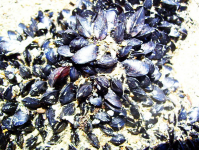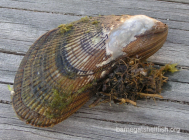|
Barnegat Bay is
home to blue mussels (Mytilus
edulis)
and Atlantic ribbed mussels
(Geukensia
demissa) |
|
Mussels |
|
Mussels |
|
Mussels are
bivalves and like clams and oysters, their
shells consist two halves or valves.
They are filter
feeders, feeding by opening their shells and
using the cilia attached to their gills to draw
water and food particles into their mouths.
|
|
Blue mussel
Mytilus
edulis |
|
 Blue
mussels live in intertidal areas and inlets of
Barnegat Bay attached to rocks and other hard
substrates by strong (and somewhat elastic)
thread-like structures called
byssal threads.
These are secreted by byssal glands located in
the foot of the mussel. Blue
mussels live in intertidal areas and inlets of
Barnegat Bay attached to rocks and other hard
substrates by strong (and somewhat elastic)
thread-like structures called
byssal threads.
These are secreted by byssal glands located in
the foot of the mussel.
Unlike clams, which
feed by drawing in water and nutrients through
an incurrent siphon and then expelling wastes
using an excurrent siphon, mussels feed while
submerged at high tide, opening their shells and
using the cilia attached to their gills to
propel water and food particles into their
mouths. At low tide, the shells close. |
|
 Blue
mussels survive above the waterline at low tide
by closing their valves and trapping in water
and and function without a fresh supply of
oxygen. Once closed, the movement of cilia
is decreases or is suspended to conserve stored
oxygen in their cells. Blue
mussels survive above the waterline at low tide
by closing their valves and trapping in water
and and function without a fresh supply of
oxygen. Once closed, the movement of cilia
is decreases or is suspended to conserve stored
oxygen in their cells.
The incoming tide
submerges them again and the valves open.
built-up carbon dioxide is released and a fresh
supply of oxygen as well an nutrients become
available and they resume filtering until the
cycle is repeated at the next low tide.
It should be noted
that not all mussels live above the low tide
line so they are submerged most if not all of
the time so the process described above is not
always necessary. |
|
Atlantic ribbed mussel
Geukensia
demissa |
|
 Atlantic
ribbed mussels are relatively large with adults
grow to about four inches in length. They live
in salt marshes and flats along the shoreline of
the bay and are tolerate to fluctuation
and variations in their environment (temperature
and salinity). Atlantic
ribbed mussels are relatively large with adults
grow to about four inches in length. They live
in salt marshes and flats along the shoreline of
the bay and are tolerate to fluctuation
and variations in their environment (temperature
and salinity).
They are usually
found half-buried in mud or attached to marsh
grass roots or other surfaces by strong,
thread-like strands secreted from the mussel's
byssus gland.
|
|
 Ribbed
mussels have a glossy, ribbed shell that varies
in color from olive or yellowish-brown to black.
The Interior of the shell is iridescent blue to
silvery white. Ribbed
mussels have a glossy, ribbed shell that varies
in color from olive or yellowish-brown to black.
The Interior of the shell is iridescent blue to
silvery white.
They are filter
feeders that feed during high tide or otherwise
submerged. They open their shells slightly
to draw in water, filtering out algae and other
particles.
Ribbed mussels do
not burrow completely into the muddy or sandy
bottom but remain partially exposed. The
gills are lined with cilia, which remove oxygen
from the water, and trap plankton and organic
matter. Particles of organic nutrients are
processed into inorganic matter by the ribbed
mussel. The inorganic material is recycled back
into the mud. This concentrated inorganic
material helps to enrich the surrounding mud and
contributes to salt marsh growth (living
shoreline). |
|
Fun Fact -
Although ribbed
mussels are edible, they are tough and do not
taste as good as the popular blue mussel |
|
Ribbed mussels
spawn once per summer. During spawning
season, a ribbed mussel’s gender can be
determined by the color of its mantle: females
tend to be brownish and males are cream or
yellowish.
Larvae eventually
settle and develop into juveniles.
They can live 15 years or longer. |
|
Not So Funny
Fact -During low tide,
ribbed mussels close their shells, keeping in
waste products that can be toxic to humans. For
this reason, you should only collect mussels
during high tide. |
